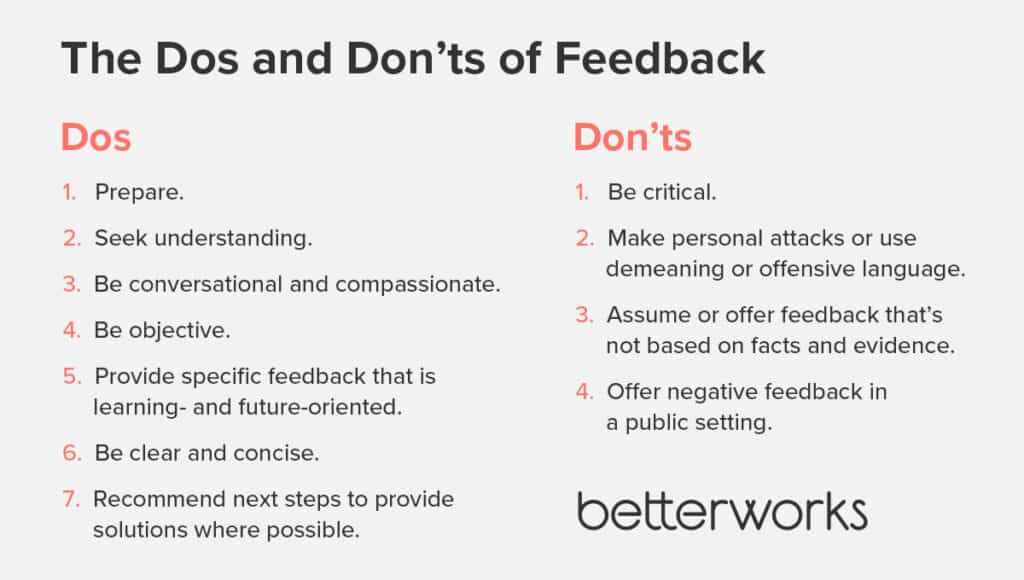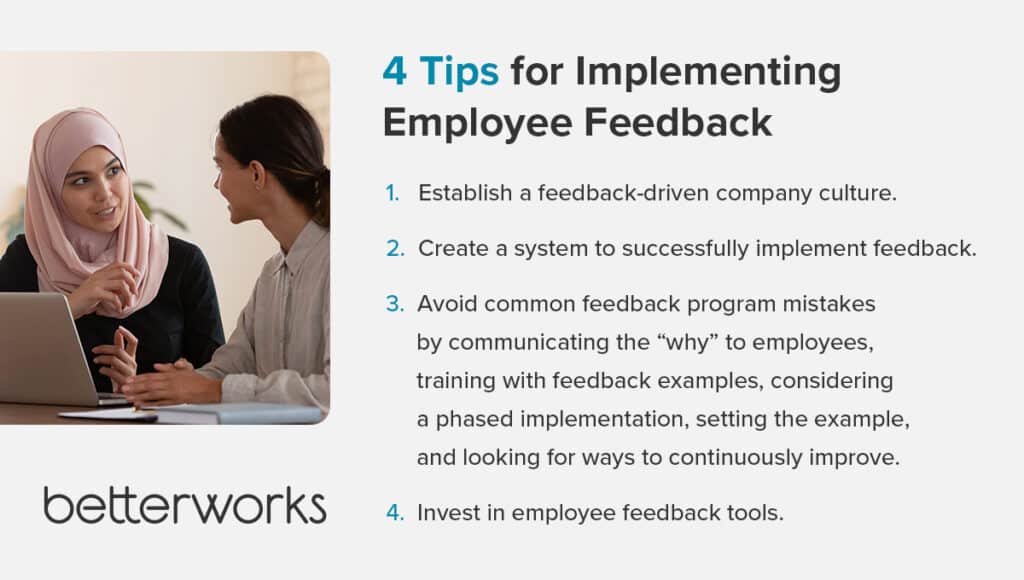Real-time, in-the-moment feedback is an essential element of performance enablement and can increase employee engagement. Yet, for many employees, it can be both difficult to request and receive feedback because it’s something that makes us vulnerable and requires us to deliver challenging messages at times.
To help ease the intimidation factor of giving or receiving feedback and promote more active engagement from employees, provide structured templates and guidance to help remove the emotion and get the conversation started. Providing good employee feedback examples will also go a long way toward helping employees establish good habits.
Those conversations are worth the effort. People crave feedback and it’s essential for improving work. According to Betterworks’ recent State of Performance Enablement report, one-quarter of employees never see feedback outside of their direct managers and 42% of employees don’t receive feedback from colleagues more than once a quarter. Two-thirds of employees wish they had a better technology solution for giving and receiving feedback and recognition.
You want your managers and peers to deliver feedback more often — and know how to give that feedback effectively. Explore the different types of employee feedback, and see them in action through employee feedback examples.
Breaking down 3 different types of feedback
Employee feedback falls into three primary categories: appreciation-focused, coaching-focused, and evaluational.
Appreciation-focused feedback
Appreciation-focused feedback acknowledges someone for what they did well or their good work in how they accomplished an outcome or deliverable. This positive employee feedback should be specific so the receiver will understand the impact they achieved and will be able to more easily repeat actions or behaviors.
Coaching-focused feedback
Coaching-focused feedback provides suggestions or guidance on how to improve an aspect of a project, deliverable, action, or behavior. It is future-oriented, helping the person understand what to do differently to achieve a better outcome the next time.
Evaluational feedback
Evaluational feedback helps the receiver to understand how their output — such as their interactions, a deliverable, or a presentation — compares with expectations. This type of feedback helps the recipient understand where they are starting from and where they should be by answering these questions: “ Did I accomplish what I set out to do? Did I meet the expectations of the audience or those impacted? Why or why not?”
Each of these types of feedback has corresponding questions that you can provide in response templates to help employees structure their observations and lower the barrier of intimidation. These templates should be available to employees if you have performance management software.
How to give employee feedback that resonates
Feedback is only useful if the receiver finds value in it. When an employee doesn’t understand feedback, thinks it’s irrelevant, or has a negative relationship with the giver, they will dismiss the feedback given and won’t apply the suggestions. Here are some tips for providing employee feedback that resonates with people.
The dos and don’ts of feedback
Like any people management process, there are best practices. Here are some of those for giving feedback to employees.
- Do seek understanding by asking questions that expand your understanding of the context and the other person’s perspective. They may have encountered challenges that you are not aware of that would change the type of feedback you provide.
- Do be conversational and compassionate so that your feedback comes across as natural, not cold, and shows understanding. When providing feedback in a tool or software, make time to follow up with a conversation so that questions can be discussed.
- Do provide employees with specific feedback that is learning- and future-oriented. The more specific your feedback is, the more likely employees are to apply it. Focusing on the future enables you to offer recommendations for improvement rather than focus on the past.
- Do be clear and concise in your feedback. People won’t understand the purpose of vague feedback or know how to apply it. Providing examples and context will help you illustrate your points.
- Recommend next steps to provide solutions where possible.
Avoid these common feedback missteps.
- Don’t be critical. If all people hear is what they did wrong or infer it from an emotional tone, they’re more likely to shut down, which damages engagement.
- Don’t make personal attacks or use language that could be seen as offensive or demeaning. If employees feel disrespected or spoken down to, they’re less likely to try to improve — and much more likely to look for a new job.
- Don’t assume or offer feedback that’s not based on facts and evidence. Feedback that comes off as accusatory or assumes negative intent makes the giver seem mean-spirited rather than helpful. That type of feedback can undermine trust between peers and employees and their managers.
- Don’t offer negative feedback in a public setting, as it can be embarrassing and uncomfortable for the employee. An experience like that can cause feelings of shame that damage working relationships between the team member and their peers.
Above all, focus feedback on improving performance and helping people develop their skills.

The importance of timing
Many managers and employees haven’t traditionally offered feedback to employees in real-time, instead waiting until formal performance reviews. But feedback is only valuable when given in the flow of work — while the behavior is occurring or immediately afterward.
Real-time feedback contributes to a better employee experience, is more objective (based on facts), and provides the opportunity for corrections to occur sooner. The impact and value of feedback diminish over time. When feedback is given too long after an event, as the givers we have to rely on our memory. But, our memories can be inaccurate, leading to feedback that is less objective, more emotional, and more biased. Additionally, the recipient might not have a chance to make corrections and there is less applicable value.
That isn’t to say you should bombard your team with input. Always-on feedback does have diminishing returns and may make the receiver feel criticized and micro-managed. Rather, a stream of meaningful interactions across formats is the bedrock of a healthy feedback culture. For example, plan on offering feedback to team members after they’ve completed projects or deliverables.
Deliver feedback without diluting it
Most employees dislike delivering negative feedback as much as their peers dislike hearing it. For that reason, many employees opt to deliver feedback as a “sandwich” — fitting constructive feedback in between two positive pieces of feedback.
While this approach might make the giver feel better, it also dilutes the impact of your feedback. Recipients tend to focus too much on one aspect or the other, either fixating on critical feedback or focusing on the praise and missing the constructive feedback.
3 examples of appreciation-focused feedback
Positive feedback is powerful when done well but turns into shallow platitudes if delivered poorly. Review these positive feedback examples to learn how to keep feedback deep, meaningful, and future-oriented.
Example #1
“Your dedication to the details of the project is what helped us to complete it on time. Your communication with the team was timely, clear, and focused on keeping everyone aligned. I particularly liked the way that you kept participants in the loop on progress and bottlenecks through weekly project meetings and your follow-through on lagging tasks to make sure nothing fell through the cracks.
Example #2
“I thought you contributed some very good creative ideas during the multiple brainstorming sessions with various stakeholders and your thoughtful follow-up questions helped people refine their ideas and generate additional ones.”
Example #3
“Every time the customer brought up a concern with the implementation, you listened intently and asked follow-up questions that helped improve our understanding of the customer’s issues. It was also clear you had done your homework because you were able to address several of their issues in the meeting and engage in problem-solving. You were also honest about the questions you couldn’t answer and followed through on your commitment to finding answers within 72 hours, which the customer really appreciated.
3 examples of evaluation and coaching-focused feedback
Evaluation-focused feedback is the most challenging to deliver effectively without people fixating on the critical aspects and missing the opportunities for growth. Here are a few examples to help you better understand how to apply such feedback in your organization.
Example #1 (Evaluation)
“The goals for the project kick-off meeting were unclear to me. I assumed it would be project planning-focused but it seemed to be more of an ideation session. For this group and this project, it will be beneficial to have structured goals and agenda topics for each meeting so attendees feel better prepared, more confident during the project roll-out, and more accountable for actions to complete. If it would be beneficial for you, I’d be happy to help you think through how to structure the goals and actions for the next meeting to provide more context.”
Example #2 (Coaching)
“You provided a very detailed and thoughtful assessment of the problem during the last meeting. I think a bigger impact and higher value-add that would have helped you to get resolution more quickly with this group would have been to include your ideas for how to possibly solve the challenge. This would help the team begin to ideate on solutions or even approve your solutions. Since you are closest to the issue, your insights are valuable for the rest of the group to hear.”
Example #3 (Coaching)
“This morning’s meeting seemed like it didn’t go as well as you may have wanted it to since we didn’t accomplish the goals you laid out. I sensed that you may have been frustrated with some of the group interactions. This has been a challenge for me to navigate as well because it can be tough for this group to maintain focus. What I have found helpful to do is to set aside some of the discussion points and capture them for future meetings. That way the group discussion can stay focused on the goal you want to achieve.
Also, I have learned that they are generally a chatty group, so providing questions and discussion materials prior to the meeting helps each person walk into the meeting with a prepared response. I would be more than happy to run through agendas or meeting structures with you if it would help you.”
4 tips for implementing employee feedback in your organization
Establish a feedback-driven company culture
Creating a feedback culture in the workplace is essential for growth, development, and collaboration. It also improves trust, transparency, and engagement. Feedback cultures are marked by an open dialog between all employees throughout the organization.
To begin the journey of building a culture of feedback, your leaders and managers need to lead by example. They should provide regular and meaningful feedback to their teams. They should also encourage their team members to request and give feedback to others, as well as accept feedback.
For any program to be successful, you must have a system of accountability. In this case, your leaders and your managers demonstrate accountability. They need to do it, encourage it, and use the feedback an employee has received as an opportunity to provide effective development coaching.
This may be a new muscle to build, but to be strong, you must first lift a heavy weight. Be patient. Communicate openly. Keep your foot on that gas pedal, don’t give up.
Create a system to successfully implement feedback
To implement a feedback program, you’ll need to meet with key stakeholders and set clear expectations and guidelines.
What are the organization’s purpose and goals for implementing feedback? What metrics will be tracked? How will the feedback be provided? Will it be captured and to whom will it be visible? Does it become part of the employee’s performance record, and if so, will feedback be used as an evaluation tool, or simply be instructive or informational, or both?
If feedback is requested by and provided between employees, have rules in place regarding the privacy of that information. You may decide that feedback among colleagues should remain a private communication rather than automatically becoming part of the employee’s performance record. Or, you may want to give employees the option of deciding whether they wish to share peer feedback with their manager.
You’ll want to take into account where your culture is at today and make a change plan to get to the end goal. For example, some cultures may be quite toxic in their current state, meaning employees have low trust in their peers, their manager, or the organization. The path to a successful, transparent, and open culture of feedback in this case may take longer than others, but that is ok.
Start by “going gentle into that good night” and allow managers to gather feedback on behalf of their employees, or instill anonymity and be thoughtful about who sees what information. This may be a new muscle to build, but to be strong, you must first lift a heavy weight. Be patient. Communicate openly. Keep your foot on that gas pedal, don’t give up.
Avoid common feedback program mistakes
Establishing a feedback program for the entire organization can take time, especially if a culture of feedback does not exist within the organization.
Communicate the “why” to employees — One common mistake is failing to clearly communicate the goals and benefits of the feedback program. Without clarity, employees won’t understand why feedback is being implemented, how it can help them, and how to effectively use the feedback they receive to improve their performance.
Train with examples — Giving and receiving feedback can be difficult if employees are unfamiliar with the types of feedback, how to ask for feedback, and how to structure their responses to feedback they have requested. Employees may be afraid to ask or share feedback for fear of saying the wrong thing or upsetting colleagues. Provide training with specific examples to help employees become accustomed to giving feedback, and share our Employee’s Ultimate Guide to Giving and Receiving Feedback.
Consider a phased implementation — Companies without a feedback culture may want to start by introducing structured feedback, which is given at certain points in time, such as at the end of a quarter or upon completion of a project. This approach can help managers and employees acclimate to the concept of giving and receiving feedback until they feel comfortable progressing to an “anytime feedback” structure. For some organizations, starting out with anytime feedback may feel intimidating to employees and could dampen participation.
Set the example — A truly successful feedback program happens at all levels of the organization. Leadership and managers should set an example for the rest of the organization and be willing to share success stories about the impact of feedback on their own work and behaviors. Transparency will inspire others in the organization to embrace feedback. Provide incentives for managers and employees to take feedback seriously. Without incentives, they might view feedback conversations as optional or not a business priority.
Look for ways to continuously improve — Feedback isn’t a one-and-done event. After you establish metrics to measure success and implement the program, follow up with managers and employees to gauge uptake, and find out what’s working and what’s not. Use pulse surveys to capture employees’ thoughts on the feedback program’s effectiveness and track changes in behaviors and performance against your metrics.
Invest in employee feedback tools
Technology for capturing and delivering feedback is essential in today’s digital workplace. Nearly two-thirds (64%) of employees wish they had a better technology solution for giving and receiving feedback and recognition, according to our State of Performance Enablement report. And 34% of managers cited technology for delivering feedback and recognition as one of the top things they need to be better managers.
While feedback is often tied to specific projects, events, and deliverables, each piece of feedback is also a data point in our employee development journey. Look for a technology solution that makes it easy to ask for and offer feedback, follow up on advice, and adjust employee goals so they align with business objectives.
Technology is a powerful support for your organization during its feedback journey. This is where a tool such as Betterworks can help by providing templates and prompts that help you and your team align to best practices.

Apply employee feedback examples
Feedback is an essential part of any successful business. Receiving feedback helps employees understand their strengths and weaknesses, which helps them focus on areas of improvement. Feedback that’s given in a supportive and constructive manner will drive positive outcomes, such as increased morale, productivity, and engagement.
Not all feedback is equal, and organizations need to understand the three main types of feedback and when to use them. HR leaders influence this process when they create structures for regular feedback conversations and provide employee feedback examples to managers and employees. When everyone is equipped to deliver and receive feedback, your workforce is primed to improve performance.
To equip your employees to thrive in a feedback culture, get The Employee’s Ultimate Guide to Giving and Receiving Feedback.
Caitlin Collins is an Organizational Psychologist and Program Strategy Director at Betterworks. She is an expert in her field on performance enablement, change enablement, and learning and development, and works with global organizations to align outcomes with business strategy.
The Employee’s Ultimate Guide to Giving and Receiving Feedback









